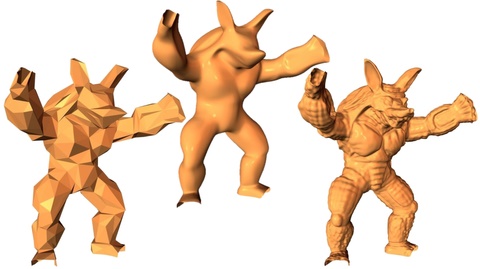Displaced subdivision surfaces

ACM SIGGRAPH 2000 Proceedings, 85-94.
Automatic conversion of detailed mesh to displaced surface, and its benefits.
Abstract:
In this paper we introduce a new surface representation, the displaced subdivision surface. It
represents a detailed surface model as a scalar-valued displacement over a smooth domain surface. Our
representation defines both the domain surface and the displacement function using a unified subdivision
framework, allowing for simple and efficient evaluation of analytic surface properties. We present a
simple, automatic scheme for converting detailed geometric models into such a representation. The
challenge in this conversion process is to find a simple subdivision surface that still faithfully
expresses the detailed model as its offset. We demonstrate that displaced subdivision surfaces offer a
number of benefits, including geometry compression, editing, animation, scalability, and adaptive
rendering. In particular, the encoding of fine detail as a scalar function makes the
representation extremely compact.
Hindsights:
The Curved PN triangle representation
involves simple accesses to the vertex buffer.
Although that surface representation is not C1, it may be "smooth enough"
to be similarly used as a domain surface for displacement mapping.
See content copyrights.